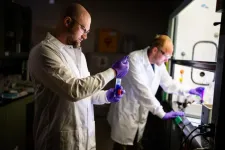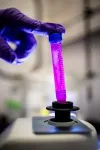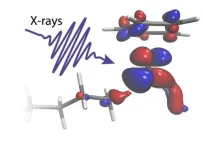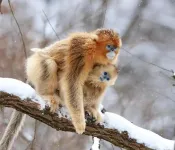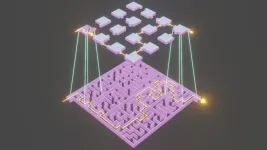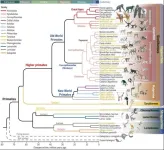(Press-News.org) ALBUQUERQUE, N.M. — A team at Sandia National Laboratories is developing materials to tackle what has become one of the biggest problems in the world: human exposure to a group of chemicals known as PFAS through contaminated water and other products. Sandia is now investing more money to take their research to the next level.
“It’s in the news constantly. It seems every day we hear of another product that is contaminated. We saw sparkling water with PFAS, toilet paper with PFAS, so it’s not just a groundwater problem; it’s popping up everywhere,” said Andrew Knight, a chemist at Sandia who has a passion for solving PFAS contamination. “It has become clear to the world it is a growing problem. It is a national security issue of a large scale.”
What are PFAS?
PFAS, an abbreviation for perfluoroalkyl and polyfluoroalkyl substances, are a group of chemicals used to make fluoropolymer products that resist heat, oil, stains and water. They are also known as “forever chemicals” because they do not break down in the environment but can move through soil and water and build up in wildlife and humans.
While human health effects from low levels of PFAS have yet to be defined by the Centers for Disease Control and Prevention, scientists have documented 12 types of PFAS in people tested and four types of PFAS in every human tested, revealing widespread exposure in the U.S. population. Tests on laboratory animals using high levels of PFAS exposure have shown an increased risk of cancer, liver damage and compromised immune systems.
PFAS are found in products including Teflon, fast food packaging, pesticides, eye makeup, cleaning products, dental floss and shampoo. However, one of the biggest contaminations identified in recent years is the groundwater under U.S. Air Force bases, which is a result of the use of PFAS-containing firefighting foam.
Creating a unique solution
Knight has been working with Ryan Davis, who specializes in materials science, to create a filter that could not only eliminate PFAS in water on a large scale but also in a household setting. “This could be something that could be deployed for major remediations or could be something that could be kept under your sink. If the initial treatment is already done, what does come through the water treatment facility through your faucet can be filtered by you, prior to end use,” Knight said.
To do this, the team must approach things differently. PFAS do not degrade on their own because the carbon-fluorine bond is so strong. They are also not the only pollutants present. This results in a sort of competition, during absorption efforts. “We are working to design materials that are more selective in absorbing PFAS. Traditional methods involve ion exchange of resins or granulated activated carbon. While these are effective at absorbing some PFAS, they lack specificity and versatility,” Knight said.
With $100,000 in recently awarded funds from the Sandia Technology Maturation Program, the team hopes to build its data to show how well the materials work. The goal is to commercialize the product to remove 99% of PFAS from water. “Our analytical lab here at Sandia is much better equipped than your average analytical lab, with Andrew’s synthetic capability and our analytical capability. It really is a perfect match,” Davis said.
A different approach inspired by nature
This project is just one of several on which these Sandia researchers are working to tackle PFAS contamination. Joined by geoscientist Mark Rigali and materials scientist Jessica Kustas, they are partnering with a local business to try a different approach that goes beyond just capturing PFAS. “It’s a one-two punch as we are combining two different technologies to develop something more effective than either one individually,” Rigali said. The materials they are working with are inspired by nature. Rigali is particularly interested in how PFAS behave in the body. He looked to medical literature for guidance and got the idea of creating a material that targets and absorbs PFAS by mimicking its behavior in humans, an approach that appears promising.
Some of their work is being paid for with $150,000 in funding from the New Mexico Technology Readiness Initiative. Through the program, Sandia and Los Alamos National Laboratories can provide technical assistance to help private companies mature technology. In this case, researchers are working with New Mexico-based Sigma Advanced Technologies, LLC.
The inspiration behind the project
The inspiration for this project also comes from personal experience. Kustas completed her post-doc with the U.S. Army where she tested water at military bases for PFAS. She found that the contamination was widespread, not just in those locations. “It’s a little scary. I saw a figure that this ‘forever chemical’ is in the blood of 97 % of the U.S. population. We consume more plastic than we realize. It used to be just in plastics, but now it’s in water and in all the animals we eat because their bodies don’t know how to break it down,” Kustas said.
For others on the team, it’s about accomplishing what no one else has. “Honestly, I like hard problems, and I like problems that can have very impactful solutions. If we can find a better way to treat PFAS, we can positively impact not only the U.S. but also places around the world,” Rigali said.
This team believes Sandia is the perfect place to accomplish this. “It’s a large-scale problem, and with Sandia’s mission of national security, water security and energy security, it’s important for Sandia to get involved. It’s something Sandia can directly tackle and address,” Knight said.
Sandia National Laboratories is a multimission laboratory operated by National Technology and Engineering Solutions of Sandia LLC, a wholly owned subsidiary of Honeywell International Inc., for the U.S. Department of Energy’s National Nuclear Security Administration. Sandia Labs has major research and development responsibilities in nuclear deterrence, global security, defense, energy technologies and economic competitiveness, with main facilities in Albuquerque, New Mexico, and Livermore, California.
Sandia news media contact: Kim Vallez Quintana, kdquint@sandia.gov, 505-537-3294
END
Sandia scientists achieve breakthrough in tackling PFAS contamination
2023-06-01
ELSE PRESS RELEASES FROM THIS DATE:
Better search for the cause of hereditary diseases
2023-06-01
So far, it has not been possible to explain the causes of around half of all rare hereditary diseases. A Munich research team has developed an algorithm that predicts the effects of genetic mutations on RNA formation six times more precisely than previous models. As a result, the genetic causes of rare hereditary diseases and cancer can be identified more precisely.
Variations of genetic sequence occur relatively frequently – on average, one in a thousand nucleotide of a person’s genome is affected. In rare cases, these changes can lead to defective RNAs and hence non-functional proteins. This can lead to dysfunction in individual organs. If a rare disease is suspected, computer-assisted ...
Cross-cultural analysis reveals evolution and persistence of body-based measurement systems
2023-06-01
Body-based units of measure have cognitive and behavioral advantages over standardized measurement systems, according to a new cross-cultural analysis of the use of body-based measurement in more than 180 cultures worldwide, particularly in the design of ergonomic technologies. The findings reveal new insights into body-based measurement as a cultural phenomenon and may help explain the long-term persistence of their use for centuries after the emergence of standardized measurement systems were invented. The ability to measure things plays a central role in how humans understand and interact with the surrounding world and are important drivers in cultural complexity ...
Autonomous realignment and self-healing in multilayer soft electronic devices
2023-06-01
By combining two dynamic polymers, researchers present a new method for achieving autonomous realignment and self-healing in multilayered soft electronic devices and robots, according to a new study. Like human skin, self-healing polymers allow soft electronic and robotic devices to recover autonomously from various forms of damage. Such devices are often multilayered and embedded with conductive or dielectric materials to achieve functional properties while also maintaining the soft mechanical properties of the self-healing ...
Low-temperature method for 3D printing nanoscale optical-grade glass
2023-06-01
A hybrid organic-inorganic polymer resin enables the three-dimensional (3D) printing of nanoscale optical-grade glass at temperatures roughly half of what other approaches require, researchers report. According to the authors, the approach may help redefine the paradigm for the free-form manufacturing of silica glass and enable its use across a wide variety of new technological applications. Silica glasses possess a unique combination of properties, making them one of the most important materials for ...
Study tracks social, genetic evolution in Asian colobine primates
2023-06-01
CHAMPAIGN, Ill. — Asian colobines, also known as leaf-eating monkeys, have been on the planet for about 10 million years. Their ancestors crossed land bridges, dispersed across continents, survived the expansion and contraction of ice sheets and learned to live in tropical, temperate and colder climes.
A new study reported in the journal Science finds parallels between Asian colobines’ social, environmental and genetic evolution, revealing for the first time that colobines living in colder regions experienced genetic changes and alterations to their ancient social structure that likely enhanced their ability ...
X-rays visualize how one of nature’s strongest bonds breaks
2023-06-01
Embargoed until 1-Jun-2023 14:00 ET (1-Jun-2023 18:00 GMT/UTC)
The use of short flashes of X-ray light brings scientists one big step closer toward developing better catalysts to transform the greenhouse gas methane into a less harmful chemical. The result, published in the journal Science, reveals for the first time how carbon-hydrogen bonds of alkanes break and how the catalyst works in this reaction.
Methane, one of the most potent greenhouse gases, is being released into the atmosphere at an increasing rate by livestock farming as well as the continuing unfreezing of permafrost. Transforming methane and longer-chain alkanes into less harmful and in fact useful chemicals ...
New study shows how adaptations to living in a cold climate promoted social evolution
2023-06-01
For the first time ever, scientists have uncovered evidence that a species’ long-term adaptation to living in an extremely cold climate has led to the evolution of social behaviours including extended care by mothers, increased infant survival and the ability to live in large complex multilevel societies.
The new study, published today in the journal Science, was led by researchers from Northwest University in China and a team including the University of Bristol (UK) and the University of Western Australia, ...
People divide complex tasks into simpler subtasks in a way that balances ease of planning with efficient behavior, consistent with a new computational theory
2023-06-01
Article URL: https://journals.plos.org/ploscompbiol/article?id=10.1371/journal.pcbi.1011087
Article Title: Humans decompose tasks by trading off utility and computational cost
Author Countries: USA
Funding: This research was supported by John Templeton Foundation grant 61454 awarded to TLG and NDD (https://www.templeton.org/), U.S. Air Force Office of Scientific Research grant FA 9550-18-1-0077 awarded to TLG (https://www.afrl.af.mil/AFOSR/), and U.S. Army Research Office grant ARO W911NF-16-1-0474 awarded to NDD (https://www.arl.army.mil/who-we-are/directorates/aro/). ...
LSU researchers show mobile elements monkeying around the genome
2023-06-01
Baboons (Papio) are found across the continent of Africa, from the west to the east and all the way south. They have doglike noses, impressive teeth and thick fur that ranges widely in color between the six species, which are olive, yellow, chacma, Kinda, Guinea and hamadryas. Their habitats vary from savannas and bushlands to tropical forests and mountains. Chacma baboons, the largest at up to 100 pounds, are even found in the Kalahari Desert, while the neighboring Kinda baboons, the smallest at around 30 pounds, stay near water. Most live in large troops with dozens or hundreds of members. While most baboons ...
The Primate Genome Project unlocks hidden secrets of primate evolution
2023-06-01
Co-led by Guojie Zhang from Centre for Evolutionary & Organismal Biology at Zhejiang University, Dong-Dong Wu at Kunming Institute of Zoology, Xiao-Guang Qi at Northwest University, Li Yu at Yunnan University, Mikkel Heide Schierup at Aarhus University, and Yang Zhou at BGI-Research, the Primate Genome Consortium reported a series of publications from its first phase program which includes high quality reference genomes from 50 primate species of which 27 were sequenced for the first time. These studies provide new insights on the speciation process, genomic diversity, social evolution, ...
